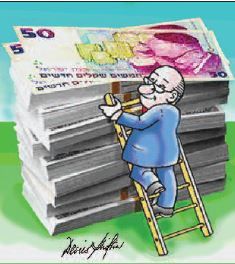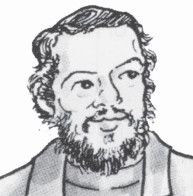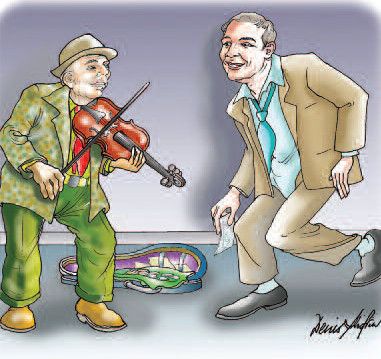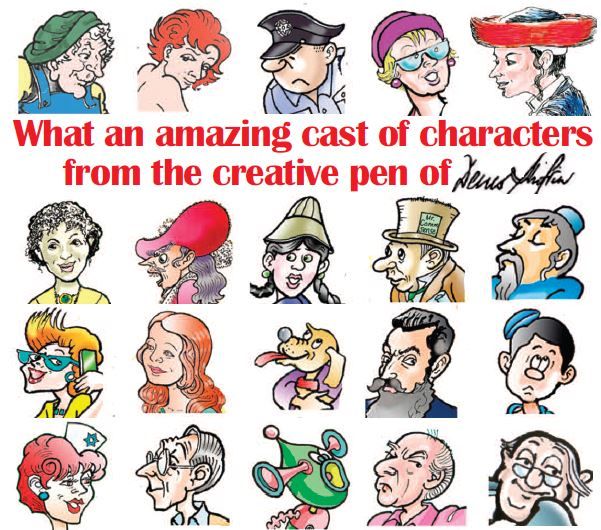The Illustrating Man
Whenever a feature needed brightening up we turned to quick-on-the-draw Denis
I have known Denis Shifrin for years, and I liked him even before ever I met him. As long-time artist, illustrator, and cartoonist par excellence for ESRAmagazine, Denis' work has graced innumerable articles over the many years he has contributed to the "mag". He has also provided an enjoyable added value and extra dimension to more than one of the articles I have written for the magazine over the years, always drawing me to look a lot better than I actually do in real life. So when ESRA Editor Merle Guttmann asked me to interview this very special man for our 200thissue, I literally jumped at the chance.
Walking into Denis' small Raanana apartment is like entering a unique art gallery, or perhaps museum, containing a fascinating array of kinetic wooden sculptures; busts of cartoonish looking people who look like everyone from Hillary Clinton to Charles de Gaulle; small figures, mostly made of wood, filling literally every bit of available shelf space; and thought-provoking paintings lining the walls. All of these things were created by Denis. Venturing into another room, we find easels and brushes for painting, vices and tools for woodworking, a large desktop computer, and countless other pieces of work and creative accoutrements of a lifelong artist.
He was born nearly 92 years ago in Liverpool. "I believe that my parents and a lot of people who came from Russia during that period, 1904, believed that they had arrived in the golden land of America when they got off the boat in Liverpool," he says with laughter.
Denis' father was a cabinetmaker, a master carpenter, a craftsman in wood. "He was very proud of being a perfectionist. I've been in wood all my life. My father wouldn't let me get into it at all. He said, 'I have to work with my hands. But you'll go to work with your head.' He wouldn't let me go near any of the woodworking machinery. I was very unhappy, because I loved the smell and texture of wood, and what you could do with wood. So that was my life at that point: living in wood, but not being allowed to have anything to do with it."
Nevertheless, Denis credits his father with instilling the basics of his artistic vision. "My father had a wonderful method of teaching me, because he was something of an artist himself. He said that one has to look at things not merely to see them, but to see what they really are. As we used to go through parks walking, when I was a small boy, all of a sudden he'd tell me, 'Stop. Don't turn around. Tell me what you just saw.' If I said I saw an old lady, he'd ask me what she was wearing. I'd say "Orange shoes". This taught me how to look at things and record them."
As the years passed, Denis retained his passion for art while acquiring a strong interest in another field. He recalls, "Just before university, there were two things I wanted to do with my life: one was to become a doctor, like a lot of Jewish boys at that time; and the other was to be an artist. I think I started drawing before I spoke. My parents weren't very happy about that. They said I couldn't make a living in art."
So Denis went to medical school, hoping at one point to perhaps be a doctor and an artist at the same time. He imagined himself becoming a medical artist, of the type who illustrated medical textbooks like Grey's Anatomy and, now, medical web sites on the internet. But life, as the old saying goes, is something that happens to you while you're busy planning something else.
By the time he got to Liverpool University, Denis was already a confirmed Zionist and member of the Habonim youth movement. It was there that he was persuaded by the shlichim from Israel to not go to medical school. "I was told, 'We've already got too many doctors. They're cleaning shop windows on Allenby Street. We need pioneers'." Denis left the university — "It almost broke my parents' hearts," he says — and went to a Habonim training kibbutz, where members were taught the value of hard physical labor, agriculture and cooperative living, and were instilled with the burning desire to build a new country in the Jewish homeland.
But having illustrated the youth movement's newspaper for years, as well as having almost single-handedly put together a large and very successful exhibition for Habonim in London in 1946, Denis became known throughout the youth movement as "The Artist." He met his wife, Gussie, at Habonim's London commune in Hackney in 1948. They came here together on aliyah in 1949, and were among the founding members of Kibbutz Kfar HaNassi near Rosh Pina.
"This was mainly 99 percent English, with all of the English style of living, even somewhat exaggerated. Tea at five o'clock and that sort of thing," he recalls, with laughter. And they somehow managed to maintain this lifestyle, Denis says, even while they were all still living in tents. "They made me a carpenter." He recounts a humorous story of trying to cut glass to make windows with somewhat limited success. But he was also still 'the artist.' "I drew the plates for the kibbutz Haggadah, all the decorations for holidays and festivals."
The Shifrins' eldest child was born in 1950 and, as was customary at the time, was placed and cared for in the kibbutz children's house. "And my wife, Gussie, bless her heart, couldn't stand the idea of the children's house. In the years since, we've learned how dangerous those places were, both for the children and the parents. It was a terrible thing in retrospect. Anyway, we left the kibbutz. It was quite a life. I would love to have stayed on. But I appreciated what Gussie was going through in relation to the children's house.
"We had no money. The only thing we came out of the kibbutz with were six diapers for the child." Denis recalls that their departure from the kibbutz probably could not have happened at a less opportune moment in Israel's history. New immigrants from Europe, North Africa, and the Middle East were streaming in by the hundreds of thousands. Work and housing were scarce to non-existent. The young family, however, harbored no thought of leaving Israel, and luckily soon got a small bungalow from the Jewish Agency.
"But what was my work? I had nothing but a pathetic portfolio of drawings." So one fine day in 1951, Denis found himself, portfolio of drawings in hand, in the office of Gershom Schocken, Editor-in-Chief of the newspaper Haaretz. Schocken told Denis that the paper could not afford a cartoonist, but sent him round the corner to a printing company, Lion the Printer, where, despite "knowing absolutely nothing" about professional printing, Denis managed to impress Mr. Lion, the company's owner, with a few quick and very game answers to his interview questions. Denis was hired on the spot and worked there for what he remembers as "nine wonderful years." He augmented his low salary by illustrating for children's books and magazines and founding a young children's magazine, Etzba'oni.
Following the death of Mr. Lion, Denis then went into advertising, working as a partner in an advertising agency for a while before forming his own company with a partner, Shifrin and Na'aman. The agency soon became involved with advertising for companies in Israel's burgeoning new hi-tech sector and others. They prospered until the war year, 1967 when, Denis says, "everybody stopped advertising."
When his two sons had grown, Denis opened a new agency with his sons. Both had studied in the U.S.A. His daughter found her place in education. The agency prospered, but when his wife had a stroke in 1985, Denis retired to care for Gussie full time. "She had helped me all my life with whatever I was doing, so I decided it was my turn. I told the kids; it's all yours now. I'm now devoting all my time to your mother." Denis did, and Gussie lived another 30 years, until 2015.
Denis has two sons, one daughter, seven grandchildren and seven great-grandchildren, all living in Israel. He keeps busy with his art, now chiefly drawing. His cartoons, like the one gracing this very article, have been taking our ESRAmagazine to new levels of excellence for many years.
Ad mea v'esrim, Denis, and keep on drawing!













Comments